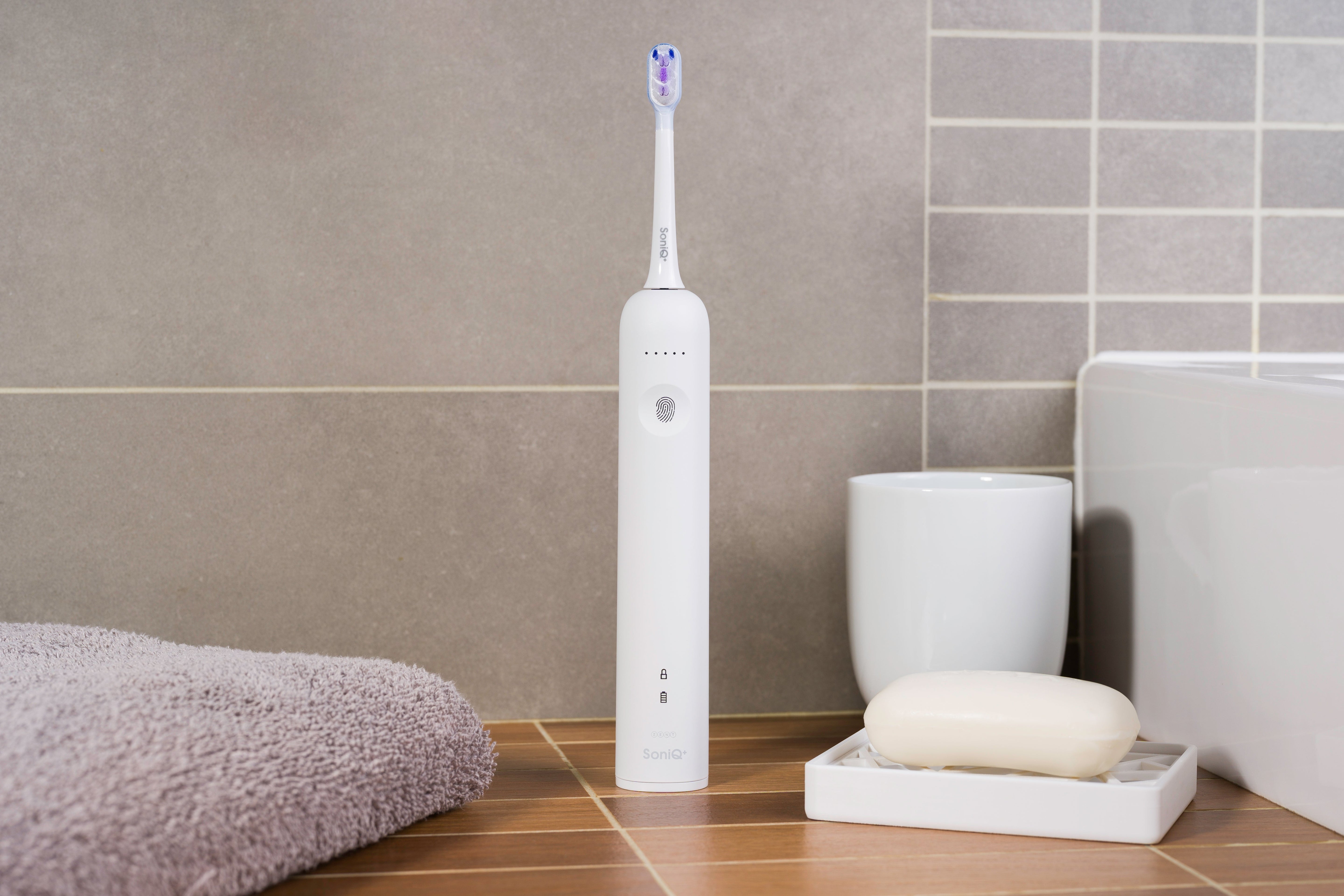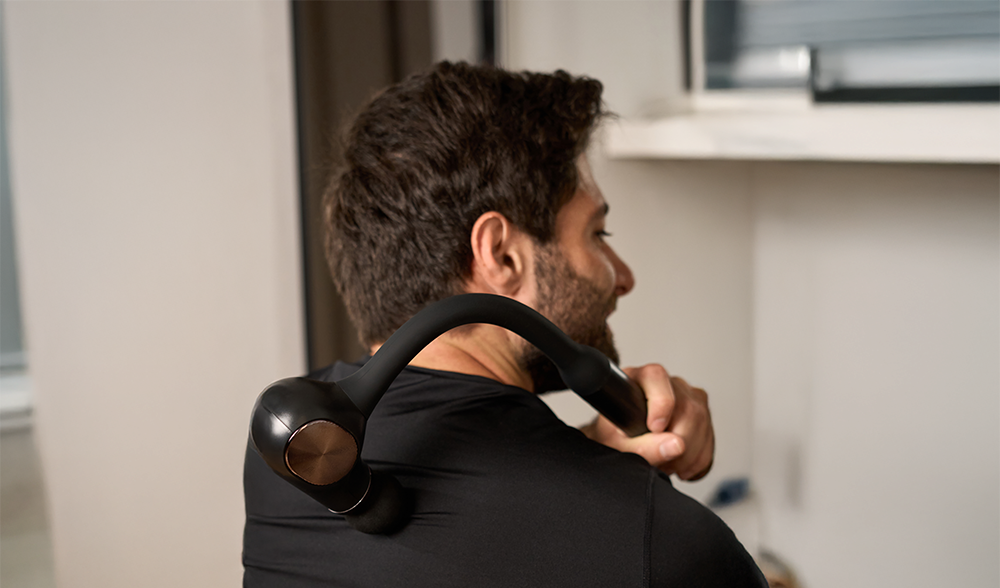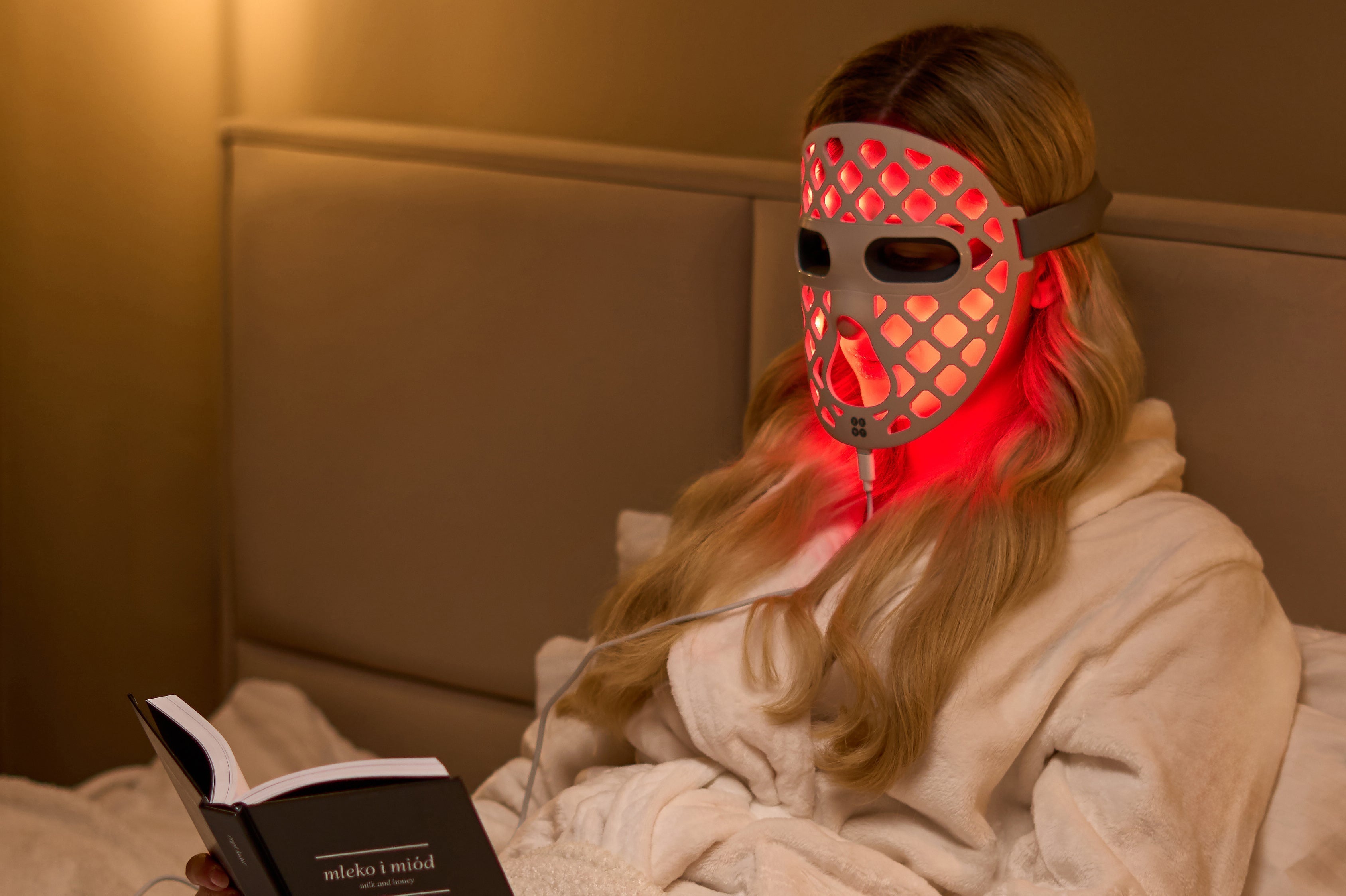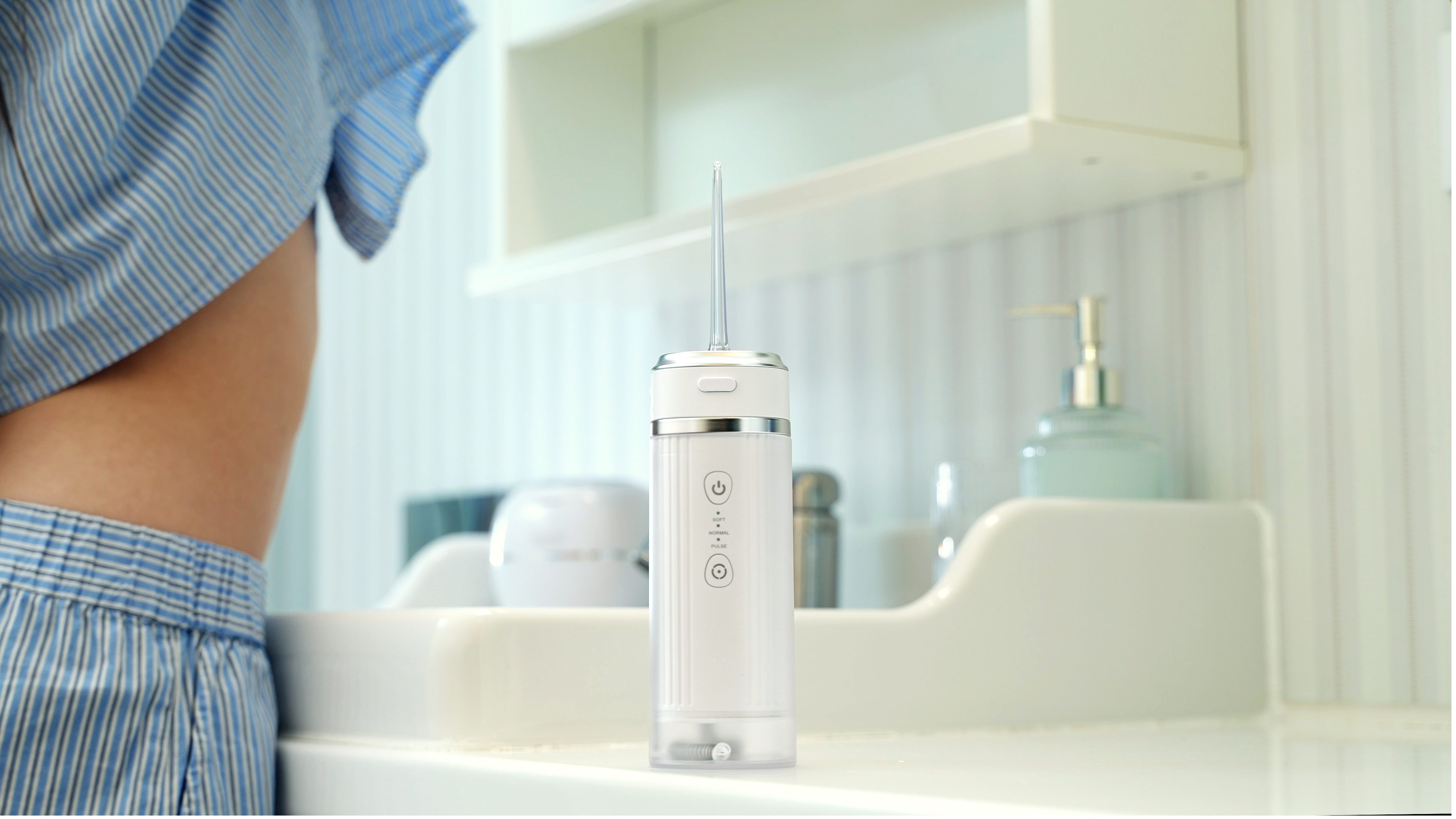"Sonisk eller oscillerande tandborste – vilken är bäst att välja?" är en av de vanligaste frågorna som ställs av personer som söker en ny apparat för munhygien. Dessa två huvudtyper av apparater har olika sätt att fungera och olika fördelar. I denna artikel jämför vi deras effektivitet och karaktäristiska egenskaper för att hjälpa dig fatta ett medvetet beslut som passar dina behov.
Se även: Manuell eller sonisk tandborste? [...]
Hur fungerar en sonisk tandborste?
Den soniska eltandborsten använder avancerad vibrationsteknologi. Traditionella tandborstar rengör bara de områden som borsten direkt berör. Den soniska tandborsten fungerar annorlunda – den skapar dynamiska vätskeflöden i munnen. Dessa flöden når mellan tänderna och under tandköttskanten. Studier har visat att deras effekt sträcker sig upp till 4 mm bortom borststrånas kontaktområde [1].
Nyckelfunktioner för sonisk tandborste:
- genererar hög vibrationsfrekvens (från 20 000 till 62 000 per minut),
- gör snabba rörelser från sida till sida (till skillnad från roterande rörelser i roterande tandborstar),
- skapar mikrobubblor som hjälper till att bryta ner plack på svåråtkomliga ställen [2],
- har vanligtvis ett förlängt huvud liknande en traditionell manuell tandborste,
- erbjuder tystare drift jämfört med oscillerande och roterande modeller.
 Sonisk tandborste – hur många rotationer gör den?
Sonisk tandborste – hur många rotationer gör den?
När vi talar om soniska tandborstar använder vi inte termen "rotationer", utan snarare "vibrationer" eller "svängningar". Kliniska studier visar att det optimala antalet är minst 30 000 vibrationer per minut [3]. De mest avancerade modellerna erbjuder upp till 62 000 rörelser per minut, vilket avsevärt ökar deras effektivitet vid borttagning av plack.
Se även: Hur man väljer den bästa tandborststerilisatorn?

Vilken sonisk tandborste är bäst?
När du väljer den bästa soniska tandborsten är det värt att uppmärksamma några viktiga parametrar:
- vibrationsfrekvens – de bästa modellerna ger minst 30 000 vibrationer per minut,
- soniska tandborsthuvuden – bör vara lätta att byta ut och finnas i olika varianter,
- driftslägen – en bra sonisk tandborste erbjuder minst 2-3 rengöringsprogram,
- batteritid – optimalt 2-4 veckor på en laddning,
- ytterligare funktioner – timer, tryckindikator, Bluetooth-anslutning.
Typer av roterande tandborstar
Det är viktigt att skilja på tre huvudtyper av roterande tandborstar som ofta förväxlas eller används omväxlande:
- Roterande tandborste – utför fulla roterande rörelser (360°) i en riktning,
- Oscillerande tandborste – utför pendelrörelser (alternerande höger och vänster) inom ett område som inte överstiger 360°,
- Oscillerande roterande tandborste – kombinerar båda rörelsetyperna, utför både oscillerande (pendelrörelser) och roterande (roterande rörelser).
Hur fungerar en oscillerande roterande tandborste?
Oscillerande roterande tandborste fungerar genom ett roterande huvud som gör alternerande rörelser åt höger och vänster (oscillationer) och kan utföra fulla rotationer. Denna rörelse kombineras ofta med pulseringar som ökar rengöringseffektiviteten, därav det fullständiga namnet ofta är elektrisk oscillerande pulserande roterande tandborste.
Kännetecknande drag för oscillerande roterande tandborste:
- rund, mindre borsthuvud som utför oscillerande och roterande rörelser,
- oscillationsfrekvens vanligtvis från 7 000 till 10 000 per minut [4],
- ofta utrustad med pulserande teknik,
- mekanisk borttagning av plack genom direkt kontakt mellan borststråna och emaljen,
- tydligt kännbar rörelse under borstning.
Oscillerande roterande tandborste – ranking över de mest populära modellerna
När man granskar rankingen över de mest populära modellerna av oscillerande roterande tandborstar på den polska marknaden hittar vi enheter som kombinerar oscillerande roterande teknik med pulserande. En sådan elektrisk oscillerande pulserande roterande tandborste ger mångdimensionell rengöring och tar noggrant bort beläggningar från tändernas yta.
Enligt oberoende kliniska tester utförda av Cochrane Oral Health Group, visar oscillerande roterande tandborstar 11 % högre effektivitet i att minska plack på kort sikt och 21 % högre effektivitet på lång sikt jämfört med manuella tandborstar [5].
Sonic-tandborste och oscillerande – nyckelskillnader
När man jämför sonic-tandborsten och den oscillerande bör man uppmärksamma några viktiga skillnader:
|
Egenskap |
Sonic-tandborste |
Oscillerande roterande tandborste |
|
Huvudrörelse |
Sidovibrationer |
Rotationer höger och vänster (cirkulära) |
|
Huvudform |
Avlång (som i manuell) |
Rund, mindre |
|
Antal rörelser |
20 000-40 000/min |
7 000-10 000/min |
|
Rengöringsräckvidd |
Upp till 4 mm utanför fibrerna |
Direkt fiberkontakt |
|
Borstringsteknik |
Liknande manuell |
Kräver tillvänjning |
|
Arbetsvolym |
Tystare |
Högre ljudnivå |
|
Rengöringsnoggrannhet |
Jämnare, mildare |
Intensiv vid kontaktpunkten |
|
Påverkan på tandköttet |
Mindre risk för irritationer [6] |
Större risk vid för hårt tryck |
Sonisk tandborste och effekter – vad får du genom att välja sonisk teknik?
Vilka hälsoeffekter ger en sonisk tandborste? De är bekräftade av kliniska studier och inkluderar flera fördelar för munhälsan:
- djupare rengöring – sonisk teknik når svåråtkomliga områden tack vare hydrodynamisk effekt [7],
- skonsam mot tandköttet – studier visar mindre risk för skador på tandköttet och retraktion [8],
- mindre slitage på emaljen – skonsammare verkan skyddar tandytan, vilket bekräftas av laboratoriestudier på emaljprover [9],
- bättre effektivitet med tandställningar – enklare manövrering runt fästen,
- reducering av missfärgningar – effektivare borttagning av plack som leder till gulnande tänder.
 Sonisk tandborste – hur använder man den?
Sonisk tandborste – hur använder man den?
För att uppnå bästa resultat med en sonisk tandborste, är det bra att veta hur man använder den. Vi rekommenderar att följa några regler bekräftade av tandläkare [10]:
- Fukta borsthuvudet och applicera en liten mängd tandkräm (stor som ett ärta).
- Sätt på tandborsten först när den är mot tänderna (undvik att tandkräm stänker).
- Flytta långsamt borsthuvudet längs tandraden och stanna 2-3 sekunder vid varje tand.
- Tryck inte för hårt – låt den soniska teknologin göra sitt jobb (de flesta modeller har trycksensor).
- Borsta i fulla 2 minuter (de flesta modeller har en inbyggd timer).
- Kom ihåg att byta borsthuvud regelbundet (var tredje månad).
Sonisk-roterande tandborste – en revolution inom tandrengöring
En innovativ lösning på marknaden är en sonisk-roterande tandborste som kombinerar fördelarna med båda teknologierna. Denna hybrida typ är en tandborste som samtidigt erbjuder fördelarna med sonisk och oscillerande-roterande teknik.
Ett exempel på en sådan enhet är ZENT SoniQ+ – den första soniska roterande tandborsten med Dual-Motion-teknologi på den polska marknaden. ZENT SoniQ+ kombinerar 31 000 soniska vibrationer och 180 oscillationer per minut i ett unikt 60°-område, vilket ger en djup och precis rengöring av tänderna.
Vad som utmärker moderna sonisk-roterande tandborstar som ZENT SoniQ+:
- Dual-Motion-teknologi – samtidig sonisk vibration och oscillation,
- Modified Bass-metoden – erkänd av forskare som den mest effektiva tandborsttekniken enligt American Dental Association [11],
- 5 olika arbetslägen anpassade för olika behov,
- 30 dagars användning på en laddning tack vare ett kraftfullt 1100 mAh batteri,
- vattentäthet IPX7 – möjlig att använda säkert i duschen,
- trådlös induktionsladdning,
- 5 års garanti – efter produktregistrering.
 Vilken sonisk tandborste för barn?
Vilken sonisk tandborste för barn?
Vilken sonisk tandborste är lämplig för barn? När du väljer en enhet för de yngsta är det viktigt att uppmärksamma modeller som är speciellt utformade för deras behov. Pediatriska studier visar att barn föredrar tandborstar anpassade efter deras ålder och munstorlek [12].
En sonisk tandborste för barn bör kännetecknas av:
- mindre borsthuvud anpassat för barns munnar,
- lägre vibrationsintensitet,
- färgglad, barnvänlig design,
- utbildningsfunktioner (t.ex. timer i form av en sång),
- hållbart batteri,
- vattentålighet.
Innan du köper en sonisk tandborste för barn är det bra att rådgöra med en tandläkare, som hjälper till att välja en modell som passar barnets ålder och behov.
Komplettering av munhygien
Oavsett vilken typ av tandborste du väljer är det viktigt att komma ihåg en heltäckande munhygien. Studier visar att själva tandborsten – även den bästa – bara tar bort cirka 60 % av placken [13]. Ett komplement till daglig borstning bör vara:
- regelbunden användning av tandtråd,
- användning av mellanrumsborstar,
- sköljning av munnen med specialvätskor,
- rengöring av tungan.
För personer som använder tandställningar, skenor eller proteser kan en ultraljudsrengörare, som ZENT Ultrasonic Cleaner, vara ett utmärkt komplement som effektivt tar bort bakterier och plack från dessa tillbehör.
 Se även: Ultraljudstandrengörare – vad är det för en apparat [...]
Se även: Ultraljudstandrengörare – vad är det för en apparat [...]
Sonisk eller oscillerande tandborste – vilken är bäst för dig?
Valet mellan sonisk och oscillerande tandborste beror främst på individuella behov och preferenser.
Elektrisk sonisk tandborste är bättre för personer som:
- de med känsligt tandkött och överkänsliga tänder,
- de som bär tandställning,
- de som värdesätter tyst drift,
- de som är vana vid manuell borstningsteknik.
Oscillerande roterande tandborste passar bättre för:
- personer som gillar intensivare rengöring,
- användare som föredrar tydligt kännbar borstningsrörelse,
- personer med tendens att bilda plack.
Den mest avancerade lösningen kan visa sig vara en sonisk roterande tandborste som kombinerar båda teknikerna, som ZENT SoniQ+. Kombinationen av sonisk vibration och oscillation ger den mest noggranna rengöringen, som når både tandytorna och svåråtkomliga mellanrum samt tandköttslinjer.
Oavsett val av teknik är din investering i en avancerad eltandborste ett steg mot bättre och noggrannare munhygien. Kom ihåg att ett friskt och vackert leende inte bara handlar om estetik, utan också om allmän hälsa och självförtroende. Genom att välja rätt tandborste och följa principerna för korrekt hygien får du inte bara friska tänder för livet, utan investerar också i en bättre livskvalitet.
______________________________________________________________________________________________
PRZYPISY
-
Hope CK, Petrie A, Wilson M. Effektiviteten av att ta bort sukrosodlade biofilmer med soniskt drivna eltandborstar. J Clin Periodontol. 2010;37:841-846.
-
Schmidt JC, Zaugg C, Weiger R, Walter C. Borsta utan att borsta?—en översikt av effektiviteten hos eltandborstar vid icke-kontakt biofilmborttagning. Clin Oral Investig. 2013;17(3):687-709.
-
Van der Weijden FA, Campbell SL, Dörfer CE, González-Cabezas C, Slot DE. Säkerheten hos oscillerande-roterande eltandborstar jämfört med manuella tandborstar: en systematisk översikt. J Periodontol. 2011;82(1):5-24.
-
Kurtz B, Reise M, Klukowska M, Grender JM, Timm H, Sigusch BW. En randomiserad klinisk studie som jämför plackborttagningsförmågan hos en oscillerande-roterande eltandborste med en manuell tandborste av flera bedömare. Int J Dent Hyg. 2016;14(4):278-283.
-
Yaacob M, Worthington HV, Deacon SA, et al. Elektrisk kontra manuell tandborstning för munhälsa. Cochrane Database Syst Rev. 2014;(6):CD002281.
-
Deery C, Heanue M, Deacon S, et al. Effektiviteten hos manuella jämfört med elektriska tandborstar för tandhälsa: en systematisk översikt. J Dent. 2004;32(3):197-211.
-
Adams H, Winston MT, Heersink J, Buckingham-Meyer KA, Costerton JW, Stoodley P. Utveckling av en laboratoriemodell för att bedöma borttagning av biofilm från interproximala utrymmen med elektrisk tandborstning. Am J Dent. 2015;28(1):15-20.
-
Deacon SA, Glenny AM, Deery C, et al. Olika elektriska tandborstar för plackkontroll och gingival hälsa. Cochrane Database Syst Rev. 2010;(12):CD004971.
-
Wiegand A, Begic M, Attin T. In vitro-utvärdering av abrasion av eroderad emalj med olika manuella, elektriska och soniska tandborstar. Caries Res. 2006;40(1):60-65.
-
Slot DE, Wiggelinkhuizen L, Rosema NAM, Van der Weijden GA. Effektiviteten hos manuella tandborstar efter en borstningsövning: en systematisk översikt. Int J Dent Hyg. 2012;10(3):187-197.
-
Bass CC. En effektiv metod för personlig munhygien. J La State Med Soc. 1954;106(2):57-73.
-
Davidovich E, Ccahuana-Vasquez RA, Timm H, Grender J, Cunningham P, Zini A. Randomiserad klinisk studie av plackborttagningsförmåga hos en eltandborste i en pediatrisk population. Int J Paediatr Dent. 2017;27(6):558-567.
-
Sambunjak D, Nickerson JW, Poklepovic T, et al. Flossing för hantering av parodontala sjukdomar och karies hos vuxna. Cochrane Database Syst Rev. 2011;(12):CD008829.














